Maestro Daniele Perazzi, 1932 – 2012
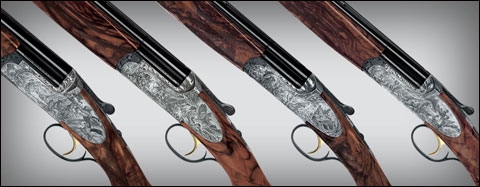
Daniele Perazzi passed away at the top of his game. Only months before his death on November 7, 2012, his eponymous shotgun company swept the London Olympics with 12 out of 15 medals, including four gold — celebrating a lifetime of international victories that elevated the Perazzi marque to the highest rungs of performance and craftsmanship.
After conquering the London Olympics, Perazzi’s reputation for building exceptional competition shotguns reached a fevered pitch in the United States. Californian Kimberly Rhode had earned a place in the history books as the first American to win a medal in five consecutive Olympics when she garnered the gold in Women’s Skeet at the 2012 Olympics with her Perazzi MX2000S.
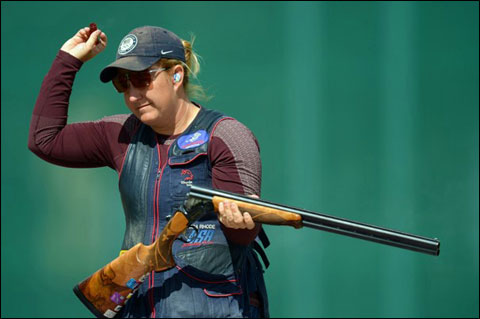
Olympian Kim Rhode with her winning Perazzi MX2000S.
Daniele Perazzi was a prodigy whose innate talent flourished with hard work, dedication and a devotion to perfection. After starting the company in 1957 in Brescia Italy, it would take only seven years to fulfil his vision of Olympic recognition. Perazzi collected its first gold for trap at the 1964 Tokyo Olympics at the hand of long-time collaborator and friend, Ennio Mattarelli. The company’s championship ways persisted into the 2012 London Olympics — another validation in a history of victories on clays courses and live pigeon rings throughout the world.
A Perazzi shotgun isn’t simply manufactured by the company. It’s born of Daniele Perazzi. It arrives from a symbiotic relationship between the man and his gun that will endure long past his death. And so we set out to understand the man through his gun.
Our quest began after Ms. Rhode’s triumph in London. The presidential campaign, then white hot, pitted two polar opposite value systems against each other in highly divisive crusades. Polemics about entrepreneurship and the viability of our American traditions resonated through the public discourse. And we wondered what kind of man was Daniele Perazzi, to launch a business in the shambles of World War II Italy, and ultimately see his hand-built masterpieces rise to the pinnacle of international competition during his very own lifetime?
The first step in our journey started with a phone call to Al Kondak, Managing Director of Perazzi USA, in Azusa, California. Was it possible, we asked him, to shoot a gun like Kim Rhode’s in order to truly comprehend the Perazzi philosophy?
Although the Perazzi production pipeline is usually tight, Mr. Kondak did have an MX8 in his inventory. Mechanically, it would be nearly identical to Ms. Rhode’s MX2000S with the exception of the trigger group. The chief difference is that the MX2000S has a fixed mechanical trigger group with coil springs, compared with the detachable mechanical trigger of the MX8 with its V-leaf springs. Perazzi is known for the detachable trigger, but the fixed trigger group provides the same degree of high performance.
During subsequent discussions with Ms. Rhode about her own MX2000S, she explained that the dependability of the fixed trigger precluded a detachable trigger group as back-up.
“I’ve never had a reliability problem with Perazzi,” she said. “I’ve shot about three-million rounds and I’ve never had one break and that’s through three guns. The barrels and triggers have never worn out. The receiver is rugged too.”
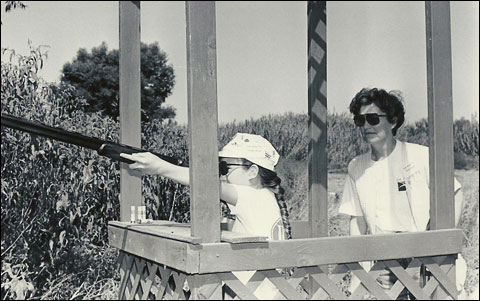
A very young Kim Rhode shooting her first Perazzi.
So in terms of match shooting, the coil-versus-leaf spring debate would likely end with no conclusive winner other than the coil spring’s reputation for marginally enhanced reliability. Otherwise, feel, lock times and pull remained virtually indistinguishable on the finished shotguns that left the factory.
Mr. Kondak and I concluded our phone call by agreeing to meet several weeks later at Orvis’ Sandanona Shooting Grounds in Millbrook, New York, during the 6th Annual Orvis Cup held in mid-September, where I could shoot clays with the MX8.
If there was a definitive shotgun to best understand Daniele Perazzi, it could very well be the MX8. In retrospect, the MX8 exemplified the Perazzi philosophy that germinated in 1960 when Daniele and a freshman engineer at Fiat named Ivo Fabbri united to research new procedures for building shotguns.
At that point, Mr. Perazzi’s own company was five years old. He had started it at age 20 to build premium sidelocks, capitalizing on his previous six-year apprenticeship at a local gun concern. The 20-year-old Mr. Perazzi had already revealed his ingenuity by inventing and patenting a single trigger that his company manufactured for the gun trade.

The early years of Daniele Perazzi at the bench of his fledgling company.
Perhaps the working-class pedigree of Mr. Perazzi and Mr. Fabbri influenced their mission, but the focus of their new venture, called Perazzi, was to modernize manufacturing practices employed by the “English best” gun makers in order to fabricate high-quality long guns affordable to most Italians.
Their aspirations reflected the optimism of 1960 Italy. The Summer Olympic Games in Rome that year were the first Olympics to be covered by television. Inflation was finally in decline. Ferrari took first, second and third in the Italian Grand Prix. And Frederico Fellini had released his ground-breaking movie, “La Dolce Vita.”
An early assignment for the duo came from Mr. Matterelli. Although he attained success with a Belgian Browning, he recruited the two Italian gunsmiths to render a trap gun for the 1964 Tokyo Olympics that would meet his rigorous specifications. With it, Mr. Matterrelli established a new record of 198/200 that won him a gold medal.
A year later, Mr. Perazzi and Mr. Fabbri dissolved their partnership. Mr. Fabbri sold back his shares and started a company under his own name to develop extraordinary pigeon guns that today sell for upwards of $200,000. Mr. Perazzi, meanwhile, continued designing and building innovative competition trap and skeet guns — refining the Perazzi credo as it would materialize in MX8 prototypes.
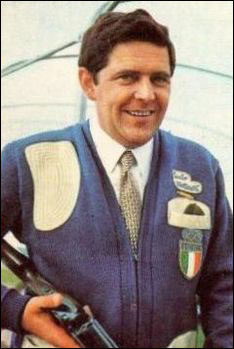
Italian trap-shooting star, Ennio Materelli.
With the departure of Mr. Fabbri, Mr. Matterelli became a partner in Perazzi. The men set their sights on the 1968 Olympics in Mexico City. The project inspired the designation MX8 (Mexico City 1968). The design goals for the new shotgun were strength, precision and balance. They vowed it would enable Mr. Matterelli to defend his title in the arduous heat and altitude of the forthcoming Olympic Games.
The MX8 Mr. Matterelli reportedly shot in Mexico City was a strengthened version of the Boss sidelock action. Indentations the shape of a flashlight beam on the interior walls of the monobloc action braced the barrels upon closing. Further stability is provided by corresponding curved extensions at the bottom of the monobloc and barrels. A bolt system projects into breach-face bits to eliminate lateral wobble. Close the gun and the proverbial vault door comes to mind.
A quick-change trigger group furnished redundancy. Slanted hammers dramatically reduced misfires. Interchangeable chokes on the bottom barrel, among the earliest available, were threaded into the muzzle of the 29¼-inch barrels. Given Mexico City’s tropical climate, a higher rib would dissipate heat quickly and evenly. A pistol grip improved control over the straight English stock. Barrel position directed recoil into the shoulder where the stock was planted into the pocket — mitigating cheek smacks and muzzle jump.
Despite the cornucopia of innovations in that early MX8, a gold medal eluded Mr. Matterelli. However, their work was not in vain. By the late 1960s, Perazzi had become a revered name in Europe for state-of-the-art shotguns.
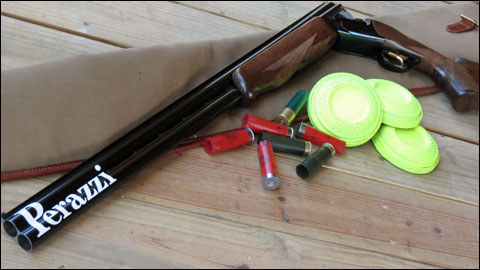
The Perazzi MX8 that was shot at Orvis Sandanona.
Fast forward 40 years to Orvis Sandanona with Mr. Kondak where our conversation concerns the MX8 he just uncased. It’s a standard-grade model with virtually no adornments. When you see the gun, it’s purity of purpose becomes immediately apparent. The Turkish walnut is nice, but perhaps not as fancy as other shotguns that cost $10,000. And the blued receiver is unadorned. In fact, it is through this gun, rather than the higher grade SCOs and Extras, that you begin to fully understand Daniele Perazzi.
That’s because Mr. Perazzi designed and built shotguns that are the equivalent of Formula 1 race cars. They are utilitarian super-high-performance tools built “to go fast.”
What does that mean? International Skeet, for example, requires that the gun start with the butt stock at hip level versus the long-established pre-mount of American Skeet. Although International Skeet targets are a tad bigger, they are sturdier and harder to break. And at 65 miles per hour, International Skeet presentations are some 30 percent faster than American Skeet targets. Rules restrict shotgun loads to 24 grams. In American Skeet, competitors can load shells of 1 ounce or more. American Skeet demands a timely pull. International Skeet has a random 0 to 3 second delay. Likewise, International Bunker Trap specifies an equal degree of difficulty over American Trap.
“You need a super-fast gun, an instinctive gun that moves without hesitation,” Mr. Kondak said.
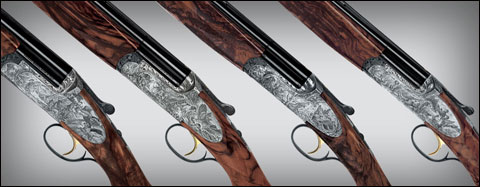
Although Perazzi’s are designed as no-nonsense competition guns, they can quickly transform into works of art as illustrated by this quartet of Extra Super MX8 shotguns.
This was a salient point in distinguishing Mr. Perazzi as a boutique gun-maker. It’s as though he designed the shotgun around a stopwatch. It’s a logical, austere and unrelenting aesthetic from the mind of an uncompromising, heads-down engineer. From Ms. Rhode’s perspective “My gun is not super high end. It’s a tool. I’m hard on it. I don’t want engraving because I’d wear it off.”
For sheer performance, the receiver of the MX8 is compact and low-profile with a central axis for quick swings. In a word: agile. At the same time, breech-to-action reinforcements ensure stability to cut recoil and facilitate a quick second shot.
Shooting five-stand at Orvis Sandanona, the MX8 felt blissfully neutral — effortless. The trigger figures prominently in the shotgun’s dynamics.

Al Kondak displaying a Perazzi MX8 detachable trigger group.
Perazzi’s mechanical, non-selective trigger with its 3½ pounds of pull is a benchmark in the industry. It’s tantamount to the steering on a Formula 1 car. Crisp and instinctive, an MX8 trigger is the shooter-gun interface that promotes nimble reflexes for crushing clays. I found the trigger unobtrusive to the extent that it actually boosted target focus.
When it comes to making barrels, Perazzi uses deep drilling instead of the more popular hammer forging. According to Mr. Kondak, hammer forging causes a higher level of molecular distortion than deep drilling — impacting barrel regulation and recoil. As I personally experienced in shooting the MX8, the gun has virtually no recoil, especially for an 8-pound shotgun. Mr. Kondak described the MX8 recoil as “round” instead of the linear wallop we usually endure — attributing the advantage in part to the “more relaxed state of the molecules” from the deep-drilling method.
For Ms. Rhode, there is a very practical aspect to deep drilling. She actually cools down the barrels in water after her relentless training sessions on a hot day. Combined with the resilient cold solder of the flat rib, she finds Perazzi barrels extremely durable. “I’ll run the barrels under water on a hot day — under a faucet, a hose or dunk them,” she said. “It’s very hard on the solder and not something I’d recommend. I’m really pushing the gun to its limits.”
The MX8 I shot was equipped with 29½-inch barrels and 2¾-inch chambers. Yes, this particular model shunned the brute force of 3-inch ammo for the finesse of smaller, lighter loads. More surprising, the 2¾-inch chambers were favored by Ms. Rhode.
“I don’t think there’s any advantage to shooting crazy-heavy loads,” she said. “You have to deal with recoil. More shot, but more recoil. If you’re shooting doubles you have to recover for the second shot. I shoot standard or light loads. If you’re on it you’re not going to miss it.”
Although the MX8 Mr. Kondak brought to Orvis Sandanona was choked skeet/skeet, Ms. Rhode keeps an armada of custom-bored Briley chokes for specific distances. She’ll also proof the chokes’ accuracy by placing her shotgun on a sandbag and testing them on a patterning board.
“I shoot very tight chokes in my skeet gun because of the distance of the reverse double in International Skeet,” she explained. “I also look for the density of my pattern since we are only shooting 24 grams of shot which is less than 7/8 ounce. I try to get a pattern that is dense enough that nothing will go through it, but as large as I can get, at the distance I need.”
Recognizing the necessity for accommodating different international competitions, Perazzi offers five different bore diameters ranging from 18.4mm to 18.8mm. By comparison, most shotgun manufacturers tend toward their own universal bore specification.
With performance and ergonomics top of mind, Perazzi shotguns are bespoke — the stocks custom built to the measurements of the shooter. Fitting a stock “is one way that we can build a gun that lets the owner shoot a gun without any hesitation to it,” Mr. Kondak explained.
“Perazzis handle real nice,” said Ms. Rhode. “They’re fast to the target and well balanced. They make the guns to fit you like a glove. The combination is incredible.”
“Incredible…” yes, that’s the one superlative to best describe Daniele Perazzi. He will be missed dearly.
Irwin Greenstein is the Publisher of Shotgun Life. You can reach him at letters@shotgunlife.com.
Useful resources:
The Perazzi web site
Kim Rhode’s Facebook page
The Orvis Sandanona web site

Irwin Greenstein is Publisher of Shotgun Life. Please send your comments to letters@shotgunlife.com.


Comments